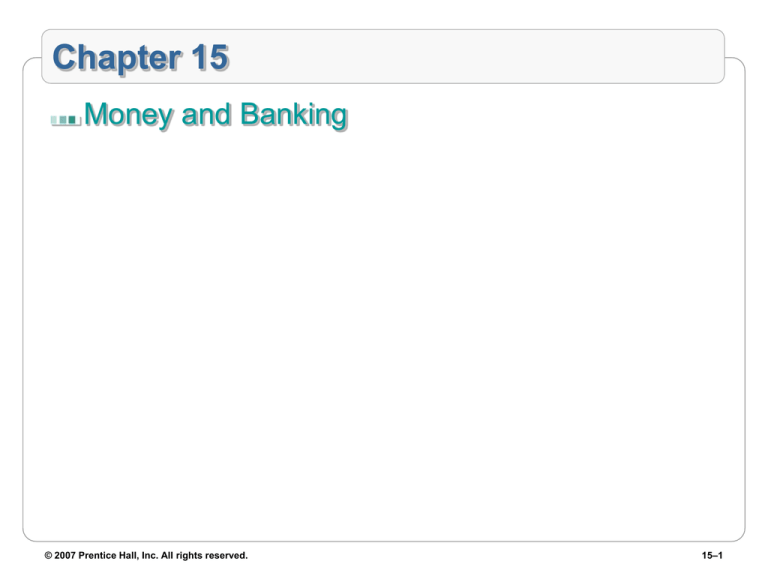
Chapter 15
Money and Banking
© 2007 Prentice Hall, Inc. All rights reserved.
15–1
LEARNING OUTCOMES
After reading this chapter, you should be able to:
Define money and identify the different forms that it takes in the
nation’s money supply.
Describe the different kinds of financial institutions that compose
the U.S. financial system and explain the services they offer.
Explain how financial institutions create money and describe the
means by which they are regulated.
Discuss the functions of the Federal Reserve system and
describe the tools that it uses to control the money supply.
Identify three important ways in which the money and banking
system is changing.
Discuss some of the institutions and activities in international
banking and finance.
© 2007 Prentice Hall, Inc. All rights reserved.
15–2
What’s in It for Me?
If you want to understand where money comes
from, and how to get the most benefits from it,
then this chapter will be useful.
The chapter explains what money is, where it
comes from, how the supply of money grows,
and the kinds of services available to money
users from the financial services industry.
© 2007 Prentice Hall, Inc. All rights reserved.
15–3
What Is Money?
Money must have:
Portability
Divisibility
Durability
Stability
© 2007 Prentice Hall, Inc. All rights reserved.
15–4
The Functions of Money
Medium of Exchange
Store of Value
Measure of Worth
© 2007 Prentice Hall, Inc. All rights reserved.
15–5
The Money Supply
M1: Spendable
Currency (paper money and coins)
Checks
Checking accounts—demand deposits in banks
M2: M1 + Convertible Money
Time deposits
Money market mutual funds
Savings accounts
© 2007 Prentice Hall, Inc. All rights reserved.
15–6
The Money Supply (cont’d)
M-3: M2 + Less Liquid Deposits
Large time deposits and sizable money market
funds by large institutions
© 2007 Prentice Hall, Inc. All rights reserved.
15–7
Credit Cards: Plastic Money?
Credit cards are not “money” and are not
included in M-1, M-2, or M-3 when measuring
the nation’s money supply.
© 2007 Prentice Hall, Inc. All rights reserved.
15–8
The U.S. Financial System
Financial Institutions
Commercial Banks
Companies that accept deposits that they
use to make loans, earn profits, pay interest
to depositors, and pay dividends to owners
Savings and Loan Associations (S&Ls)
Accept deposits, make loans, and are
owned by investors
© 2007 Prentice Hall, Inc. All rights reserved.
15–9
The U.S. Financial System (cont’d)
Financial Institutions
Mutual Savings Banks
All depositors are owners of the bank, so all profits are
divided proportionately among depositors via dividends
Credit Unions
A nonprofit, cooperative financial institution owned and run
by its members; promotes thrift
© 2007 Prentice Hall, Inc. All rights reserved.
15–10
The U.S. Financial System (cont’d)
Non-Deposit Institutions
Unlike commercial banks, inflowing funds are
intended for purposes other than earning interest for
depositors
Pension funds
Insurance companies
Finance companies
Securities investment dealers
© 2007 Prentice Hall, Inc. All rights reserved.
15–11
Special Financial Services
Individual Retirement
Accounts (IRAS)
Financial Advice and
Brokerage Services
Trust Services
Electronic Funds
Transfer (EFT)
International Services
Currency exchange
Letters of credit
Automated Teller
Machines (ATMs)
Banker’s acceptance
© 2007 Prentice Hall, Inc. All rights reserved.
15–12
Regulation of the Banking System
Federal Deposit Insurance Corporation (FDIC)
Preserves confidence in the financial system by
supervising banks and insuring deposits in banks
and thrift institutions
Commercial banks pay fees for membership in
the FDIC
The FDIC guarantees the safety of all deposits of
every account owner up to the current maximum of
$100,000
The FDIC maintains the right to examine the
activities and accounts of all member banks
© 2007 Prentice Hall, Inc. All rights reserved.
15–13
The Federal Reserve System
The Fed: The Nation’s Central Bank
Structure
Board of governors
Reserve banks
Open Market Committee
Member banks
Other depository institutions
Functions
Banking for the government
Banking for banks
Controlling the money supply
© 2007 Prentice Hall, Inc. All rights reserved.
15–14
Controlling the Money Supply
Monetary Policy
The Fed manages the nation’s economic growth by
managing money supply and interest rates
Tools of the Fed
Reserve requirements
Discount rate controls
Open market operations
Selective credit controls
© 2007 Prentice Hall, Inc. All rights reserved.
15–15
The Changing Money
and Banking System
Anti-Terrorism Regulations
Bank Secrecy Act (BSA)
USA Patriot Act
Customer Identification Program (CIP)
Interstate Banking
© 2007 Prentice Hall, Inc. All rights reserved.
15–16
The Impact of Electronic Technologies
Check 21
Allows banks to present a substitute check for
payment instead of the original check
Blink Credit Cards
A “contactless” payment system
Debit Cards
Allow the transfer of money between accounts
Used with point-of-sale (POS) terminals
© 2007 Prentice Hall, Inc. All rights reserved.
15–17
The Impact of Electronic Technologies
(cont’d)
Smart Cards
Credit-card-size plastic cards with an embedded
computer chip that can be programmed with
“electronic money”
E-Cash
Money that moves via digital transmissions on the
Internet, outside the established network of banks,
checks, and paper currency overseen by the Fed
© 2007 Prentice Hall, Inc. All rights reserved.
15–18
International Banking and Finance
World Bank
Provides a limited scope of financial services
International Monetary Fund (IMF)
Promotes the stability of exchange rates
Provides temporary, short-term loans to member
countries
Encourages members to cooperate on international
monetary issues
Encourages development of a system for
international payments
© 2007 Prentice Hall, Inc. All rights reserved.
15–19




